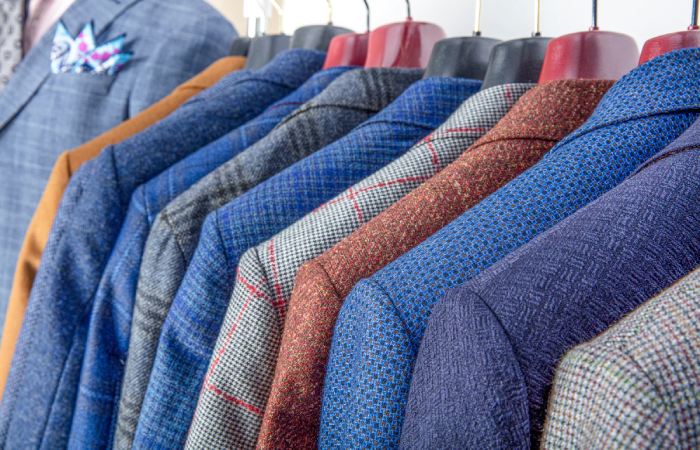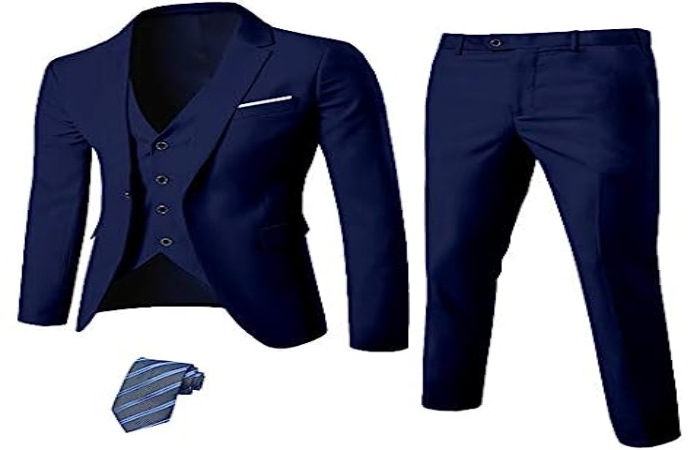Suits for Men – You decided to up your style game and invest in a suit. Excellent choice. A well-tailored suit is a wardrobe staple for any modern gentleman. But unless you are already an expert in men’s formalwear, the world of suits can seem overwhelming. There are many options to consider two-button or three-button, single or double-breasted, pinstripes or windowpane. And that before you consider the suitable fabric or the perfect fit.
Table of Contents
Types of Men’s Suits: Choose the Right Style for You
 When it comes to suits, you’ve got options. Your style says a lot about you, so pick one that fits your personality.
When it comes to suits, you’ve got options. Your style says a lot about you, so pick one that fits your personality.
The single-breasted suit is a classic and versatile choice. It has a clean-cut silhouette with one row of buttons down the front. It is a great all-purpose suit that works for most occasions.
The double-breasted suit has two rows of buttons down the front, giving it a more stylish and fashion-forward look. It’s a bold choice that perfect for confident men.
If you prefer something more casual, consider a blazer. A blazer is a lightweight jacket you can pair with khakis or slacks. It’s a step up from everyday wear but not as formal as a suit.
Then there is the three-piece suit, which includes a vest, also known as a waistcoat. The three-piece is the most formal option and works well for important business meetings, interviews, and special events like weddings.
The cut of the suit also makes a difference. American cut suits have a loose, comfortable fit, while European cut suits have a more tailored, fitted shape. Ultimately, choose a suit in color and pattern that works well. When you look good, you feel good. And when you feel good, you’ll perform at your best.
Suit Fabrics: Know Your Wool, Cotton, Linen, and Synthetic Options
 The fabric is one of your most important decisions when buying a suit. The material affects how the suit drapes, how warm or cool it is, how durable it is, and of course, how much it costs. Here are the most common options:
The fabric is one of your most important decisions when buying a suit. The material affects how the suit drapes, how warm or cool it is, how durable it is, and of course, how much it costs. Here are the most common options:
- Wool suits are considered the gold standard. Wool is breathable yet warm, drapes beautifully, and lasts long. Varieties like the Super 130s and Super 150s are lightweight and ideal for most occasions. Wool suits tend to be the most expensive.
- Cotton suits, like seersucker or linen, are incredibly lightweight and breathable, perfect for summer. However, they wrinkle very quickly and aren’t very durable. Cotton suits are on the lower end of the price spectrum.
- Linen is another lightweight, casual summer option. It’s even more wrinkle-prone than cotton but is very breathable. Linen suits have an effortless, relaxed vibe.
- Synthetic fabrics like polyester are inexpensive, durable, and wrinkle-resistant but aren’t very breathable and don’t drape as nicely as natural fibers. Polyester suits don’t have the most stylish reputation but can work in a pinch.
The occasion and climate should determine your choice of fabric. For a formal business meeting, wool is your best bet. For a beach wedding, linen or cotton is ideal. And for unpredictable weather, a wool-synthetic blend might suit you well. With so many great options, you can find a suit for any situation. Now, get fitted for that perfect fabric!
The Anatomy of a Suit: Understand the Parts
 Jacket
Jacket
The jacket is the external layer that covers the torso and shoulders. It includes the lapels, collar, sleeves, front panels, and pockets. The most common jackets for suits are:
- Single-breasted: Has a single row of buttons down the front and a narrow fabric overlap. It’s a classic, versatile style suitable for most occasions.
- Double-breasted: Two parallel rows of buttons down the front and a wide fabric overlap. It has a more casual, stylish look for formal and social events.
- Three-button: It has three buttons down the front, with the top button left undone. It’s a traditional, conservative style for business.
- Two-button: It has two buttons down the front, with the top button left undone. It’s a stylish yet professional look appropriate for most workplaces.
Pants
Suit pants, also known as trousers, provide coverage and structure for the lower body. They should reach down to your shoes and stay up at the waist. The most common fits are:
- Slim fit: Closely follows the lines of the legs with a narrow, tapered leg opening. It has a stylish, contemporary look suited for casual and social occasions.
- Regular fit: Falls straight and loosely around the legs with an average leg opening. It’s a versatile, comfortable fit appropriate for most work and social situations.
- Loose fit: Hangs broadly around the legs with a wide leg opening. It has a roomy, relaxed feel suitable only for very casual occasions.
For the most polished, professional look, choose flat-front pants over pleated pants and pair them with a belt that matches your shoes. Cuffed or uncuffed pants are a matter of personal style. Go with what you feel most comfortable and confident in.
Vest
A vest, or waistcoat, is an optional layer worn under the jacket that provides extra warmth and style. Vests come in two main types:
- Backless: Fits closely to the body with an adjustable strap in the back. Since it’s not meant to be seen under the jacket, it allows greater freedom of movement.
- Full-back: Fits closely to the body with a full back panel. It provides more coverage and structure, allowing the jacket to drape better over the torso. The full-back also allows the vest to be worn as a standalone piece.
Choose a vest of the same material and color as your suit for the sharpest look. A vest can transform your suit into stylish three-piece attire perfect for formal or social occasions.
How a Suit Should Fit: A Tailoring Guide for the Perfect Fit
 A well-fitted suit is the foundation of a polished, professional look. But getting the right fit for your body type can be tricky. Here are some tips to ensure your suit fits perfectly:
A well-fitted suit is the foundation of a polished, professional look. But getting the right fit for your body type can be tricky. Here are some tips to ensure your suit fits perfectly:
Shoulders
The shoulders are the most critical area for fit and comfort. The seam where the sleeve meets the jacket shoulder should lie flat against your natural shoulder. If it hangs over or pulls across your shoulder, the jacket is too broad or narrow, respectively.
Chest and Waist
There should be enough room to move comfortably without fabric pulling, but the jacket should drape smoothly over your chest and waist. Place two fingers between your chest and the buttoned jacket. That’s an ideal amount of room. The core should nip in slightly, but you should still be able to sit and move freely.
Sleeve Length
With your arms at your sides, the jacket sleeve should end where your wrist meets your hand. If the sleeves are too long or too short, they can be altered, but aim for no more than 1 inch of sleeve showing or needing to be let out.
Pants Length
The bottom of the pant legs should graze the top of your shoes and break slightly. Pants that are too short or too long will make even a well-fitted jacket look off. Have someone measure from your waist to your ankle while you’re standing for the proper inseam measurement.
Venting and Pleating
Single- or double-vented jackets, as well as pleated pants, provide breathability and ease of movement. Vents also accentuate your shape. Choose flat-front pants for a sleeker silhouette.
Getting the proper suit fit may take some trial and error. But focusing on these critical areas and working with an experienced tailor will ensure you have a suit you feel comfortable and confident wearing for any occasion. You’ll be ready to dress for success with the perfect fit dialed in.
Suit Care and Maintenance: Keeping Your Investment in Great Shape
Dry Clean Only
Most suits are dry clean only, so check the care label. Dry cleaning uses chemicals to clean the suit without damaging it. Steam cleaning or machine washing at home can cause damage like shrinkage, warping, or color bleeding. Take your suit to a reputable dry cleaner and tell them if any stains need special attention. For the best results, dry clean your suit every 3 to 5 years.
Proper Storage
Proper storage is key to keeping it in great shape when you’re not wearing your suit. Always store suits on padded hangers to maintain their shape. Wooden hangers can cause dents in the shoulders. Ensure the suit is fully buttoned or zipped and the collar is flat. It prevents creases from forming.
Spot Cleaning
Despite your best efforts, stains happen. Address spots and spills as soon as possible. Gently blot with a clean, damp cloth to absorb as much of the spill as possible. For protein stains like blood, egg, or urine, use a paste of water and baking soda and let it sit before rinsing with water. An over-the-counter pre-treatment can also work well for many stains. Be very careful not to spread the color by scrubbing it too hard. Dry the area once the stain is removed to avoid any ring marks.
Avoid Moth Damage and Mildew
Store your suit in a cool, well-ventilated closet away from heat and moisture sources. This environment prevents moth larvae and mildew growth. Cedar blocks, lavender sachets, or mothballs can also naturally repel moths. Pull your suit out of storage and have it dry cleaned at least once a year to refresh it before any damage can occur. With proper care and maintenance, an investment in a high-quality suit can last for many years.
Conclusion
So there you have everything you need to know to build a versatile and stylish suit collection. Whether you need something for a formal event or want to up your everyday style game, the perfect suit is out there. Now that you know different cuts, fabrics, and trends, you can confidently stroll into any menswear store and find a case that fits you perfectly. And remember, it is not about how much you spend but how well it works – a tailored suit that flatters your body type will make you look and feel like a million bucks. So start shopping and build that dapper wardrobe – you wonder how you ever lived without it. The world is your oyster, so get suited up and make it happen.

